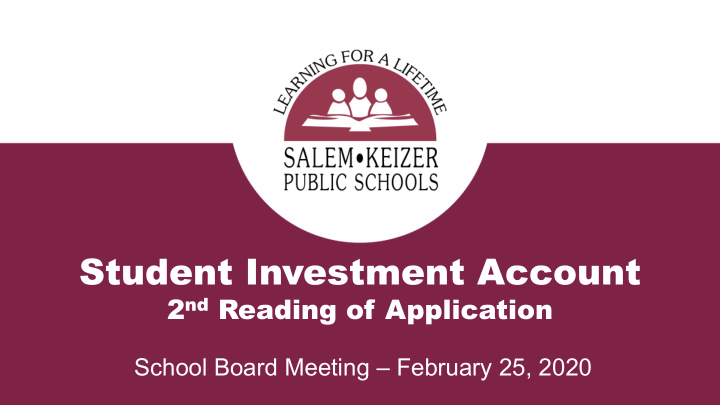



Student Investment Account 2 nd Reading of Application School Board Meeting – February 25, 2020
Tonight's Presentation • Review changes to the application • Present charter school summaries • Class size questions • Plan B considerations
Changes to the Application Community School Outreach Coordinators • Budgeted at 8 hrs at each Title I school (K-12) Addition of 1.0 licensed staff as LGBTQ+ liaison and advocate Measures of Evidence for Strategy #8
Changes to the Application Increased equity-based language Salem-Keizer is focusing on continued authentic engagement with students, families and culturally specific organizations to create partnerships, promote continuous two-way communication, and support the inclusion of the diverse cultures of our community into our schools, programs, and services, with the goal of being more culturally responsive and improving outcomes for our students. (p.18)
Changes to the Application Increased equity-based language The SIA Task Force did a thorough debrief of the engagement process in order to improve future engagement. Several of their recommendations are present in this application targeting authentic engagement with families in a continuous cycle that also reflects community voice, delegates power and builds community ownership of the Student Investment Account. In addition, we need to broaden our reach to more students and more specific groups of students and their families. (p.4)
Changes to the Application Increased equity-based language As the SIA plan was being developed, the task force and district leadership reviewed funding priorities to ensure that money was being focused on subgroups that have historically underperformed in our system. The targeted schools will be analyzed carefully to ensure we are focused on the subgroups of students most at risk for failure or lack of performance in our schools. Our initial list of focus schools reach our subgroups most at risk. (p.8)
Charter Schools • Signed memorandum of understanding from each school • Howard Street • JGEMS • Valley Inquiry • Optimum Learning Environment (OLE) • Eagle Charter School • Funding is allocated per ADMw in addition to district funding. • Charter Schools are required to align their plans with our task force priorities. • District leadership will assist charter schools to develop plans and performance metrics.
Class Size Reduction Universal class size reduction across elementary schools to a ratio of • 21:1 would cost approximately $21.7M and would require an additional 218 classrooms (approx. 8 new schools) Adding instructional assistants for two-hours per day to each • elementary classroom would cost approximately $6.9M Adding instructional assistants all day to each elementary classroom • would cost approximately $31.4M None of these address class size at middle school or high school •
Licensed Teachers in Classrooms 84 new licensed teachers in classrooms Elementary reading teachers • Middle School math teachers • Middle School language acquisition teachers • Middle School classroom teachers • High School Algebra teachers • High School Newcomer teachers • Special Education teachers • ITCC and BIC teachers •
Additional Supports for Students 98 new licensed and classified staff supporting students Elementary behavior specialists • Behavior cadre • Counselors • Classified staff in HS counseling office • Community School Outreach Coordinators (CSOC) • Zones of regulation / Safe Spaces staff • Social Workers • School Psychologists • Community Resource Specialists • McKinney Vento advocates •
Universal Supports for all Students and Schools Supports for all students and schools: Increased instructional time & teacher prep in Middle School • Targeted intervention supports at elementary level • Access to SEL curriculum for all students • Mental health supports (LCSW, community partnerships) • Zones of regulation and safe spaces • Increased translations services • Access to afterschool programs at middle school •
Schools Impacted by Plan 8 elementary schools (literacy) • 8 elementary schools (language) • 2 middle schools (math support) • 1 middle school (trauma informed practices) • 5 middle schools (ELD redesign) • 2 high schools (algebra/on-track support) • 2 high schools (newcomer/ELD supports) •
Student Investment Account This application and plan is for the estimated $35M in student • investment account funding. It does not reflect the SKPS general fund budget of approximately $520M. Its important to remember the SIA Funds are just one portion of the district's funding. If we dedicate 75% of the funds to staffing this year, to keep those • same people next year will take 81% of the funds. In 5 years, we will not have sufficient funds for the personnel costs and will need to reduce staffing. This is similar to what has happened with Title I funding.
Plan B Nonprioritized Strategies •Expansion of Plan A strategies •Portable classrooms •Transportation •Increased arts funding at pilot schools •PlayWorks recess supports •Additional Security Specialists •SKPS Parent Academy •Increased classified supports: Special Education and Bilingual supports •Curriculum & Assessment purchases •SpEd materials & supplies •Additional office staff @ targeted schools •Innovation Grants •Targeted class size reductions
Student Investment Account School Board Meeting – February 25, 2020
Recommend
More recommend